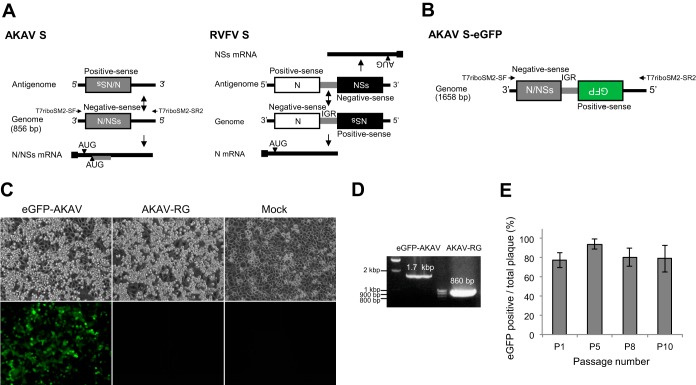FIG 1.
(A) Schematic depiction of negative-sense (AKAV) and ambisense (RVFV) gene expression strategies. AKAV, with a negative-sense strand-coding strategy, possesses an S RNA segment that contains a single transcriptional unit flanked by UTRs. The corresponding positive-sense antigenome is assumed to be transcriptionally silent. The transcriptional unit comprises overlapping ORFs accessed by alternative initiation codons. The gray bar in the N/NSs mRNA represents the NSs ORF region. RVFV, with an ambisense coding strategy, is able to transcribe mRNAs from genomic and antigenomic S RNA strands, with transcription termination signals positioned in a central IGR. A black square indicates a 5′ cap structure on mRNAs. (B) The S-eGFP plasmid was generated using RVFV and an ambisense strategy and was then used to generate eGFP-AKAV. (C) CPE and green fluorescent expression in cells infected with eGFP-AKAV or AKAV-RG or in mock-infected cells. Bright-field (top) and fluorescence (bottom) images are shown. (D) HmLu-1 cells were infected with recombinant or parental virus and analyzed using RT-PCR and electrophoresis to detect S segment RNA. The pair of primers (T7riboSM2-SF and -SR2) used for RT-PCR is indicated in panels A and B. (E) Genetic stability of eGFP-AKAV. HmLu-1 cells were infected with various dilutions of eGFP-AKAV at passages 1, 5, 8, and 10. At 3 days p.i., the number of eGFP-positive plaques was determined. The results are presented as the means ± standard deviations (SD) (error bars) from 4 or 5 wells.

